Paper Menu >>
Journal Menu >>
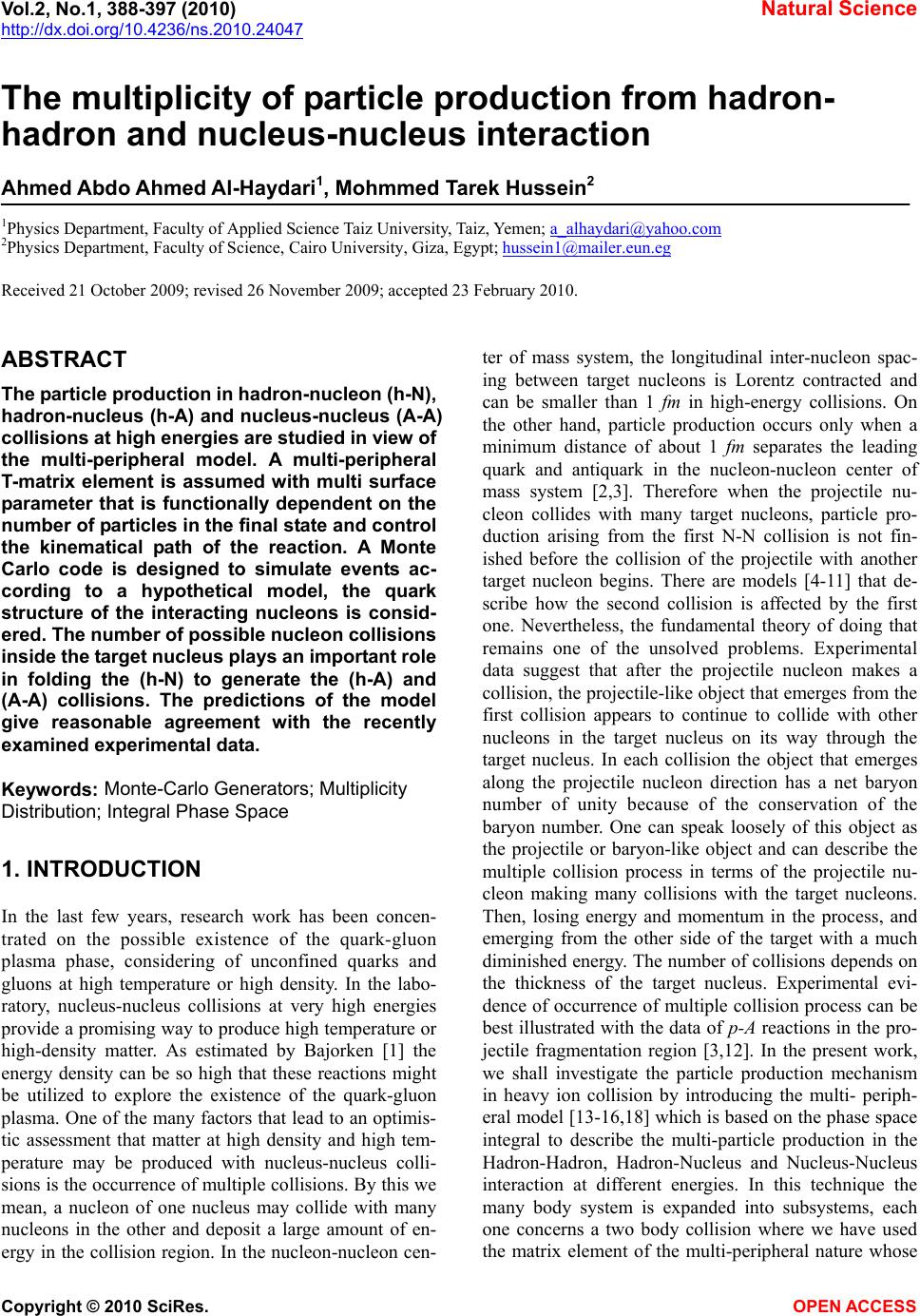 Vol.2, No.1, 388-397 (2010) Natural Science http://dx.doi.org/10.4236/ns.2010.24047 Copyright © 2010 SciRes. OPEN ACCESS The multiplicity of particle production from hadron- hadron and nucleus-nucleus interaction Ahmed Abdo Ahmed Al-Haydari1, Mohmmed Tarek Hussein2 1Physics Department, Faculty of Applied Science Taiz University, Taiz, Yemen; a_alhaydari@yahoo.com 2Physics Department, Faculty of Science, Cairo University, Giza, Egypt; hussein1@mailer.eun.eg Received 21 October 2009; revised 26 November 2009; accepted 23 February 2010. ABSTRACT The particle production in hadron-nucleon (h-N), hadron-nucleus (h-A) and nucleus-nucleus (A-A) collisions at high energies are studied in view of the multi-peripheral model. A multi-peripheral T-matrix element is assumed with multi surface parameter that is functionally dependent on the number of particles in the final state and control the kinematical path of the reaction. A Monte Carlo code is designed to simulate events ac- cording to a hypothetical model, the quark structure of the interacting nucleons is consid- ered. The number of possible nucleon collisions inside the target nucleus plays an important role in folding the (h-N) to generate the (h-A) and (A-A) collisions. The predictions of the model give reasonable agreement with the recently examined experimental data. Keywords: Monte-Carlo Generators; Multiplicity Distribution; Integral Phase Space 1. INTRODUCTION In the last few years, research work has been concen- trated on the possible existence of the quark-gluon plasma phase, considering of unconfined quarks and gluons at high temperature or high density. In the labo- ratory, nucleus-nucleus collisions at very high energies provide a promising way to produce high temperature or high-density matter. As estimated by Bajorken [1] the energy density can be so high that these reactions might be utilized to explore the existence of the quark-gluon plasma. One of the many factors that lead to an optimis- tic assessment that matter at high density and high tem- perature may be produced with nucleus-nucleus colli- sions is the occurrence of multiple collisions. By this we mean, a nucleon of one nucleus may collide with many nucleons in the other and deposit a large amount of en- ergy in the collision region. In the nucleon-nucleon cen- ter of mass system, the longitudinal inter-nucleon spac- ing between target nucleons is Lorentz contracted and can be smaller than 1 fm in high-energy collisions. On the other hand, particle production occurs only when a minimum distance of about 1 fm separates the leading quark and antiquark in the nucleon-nucleon center of mass system [2,3]. Therefore when the projectile nu- cleon collides with many target nucleons, particle pro- duction arising from the first N-N collision is not fin- ished before the collision of the projectile with another target nucleon begins. There are models [4-11] that de- scribe how the second collision is affected by the first one. Nevertheless, the fundamental theory of doing that remains one of the unsolved problems. Experimental data suggest that after the projectile nucleon makes a collision, the projectile-like object that emerges from the first collision appears to continue to collide with other nucleons in the target nucleus on its way through the target nucleus. In each collision the object that emerges along the projectile nucleon direction has a net baryon number of unity because of the conservation of the baryon number. One can speak loosely of this object as the projectile or baryon-like object and can describe the multiple collision process in terms of the projectile nu- cleon making many collisions with the target nucleons. Then, losing energy and momentum in the process, and emerging from the other side of the target with a much diminished energy. The number of collisions depends on the thickness of the target nucleus. Experimental evi- dence of occurrence of multiple collision process can be best illustrated with the data of p-A reactions in the pro- jectile fragmentation region [3,12]. In the present work, we shall investigate the particle production mechanism in heavy ion collision by introducing the multi- periph- eral model [13-16,18] which is based on the phase space integral to describe the multi-particle production in the Hadron-Hadron, Hadron-Nucleus and Nucleus-Nucleus interaction at different energies. In this technique the many body system is expanded into subsystems, each one concerns a two body collision where we have used the matrix element of the multi-peripheral nature whose 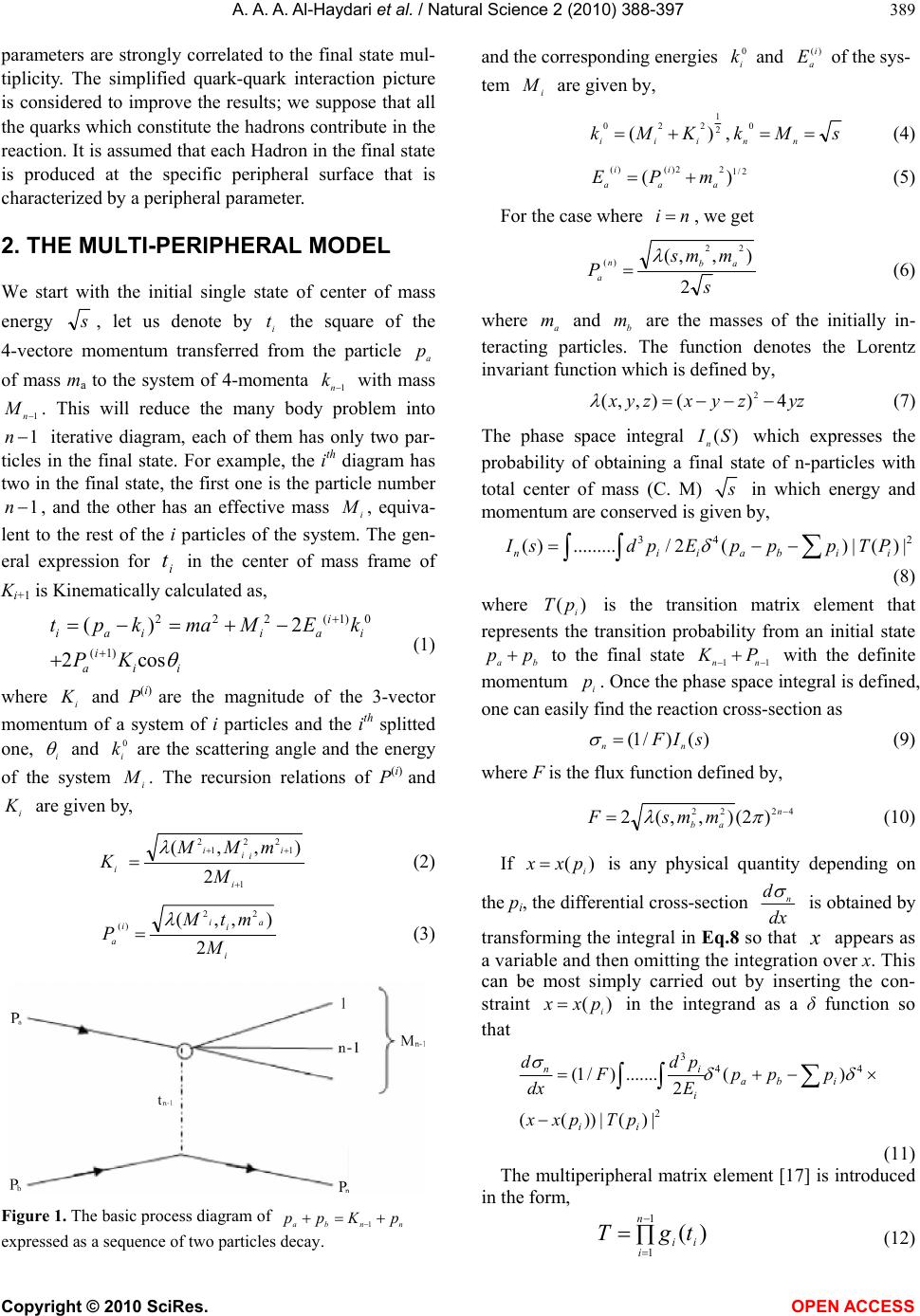 A. A. A. Al-Haydari et al. / Natural Science 2 (2010) 388-397 Copyright © 2010 SciRes. OPEN ACCESS 389 parameters are strongly correlated to the final state mul- tiplicity. The simplified quark-quark interaction picture is considered to improve the results; we suppose that all the quarks which constitute the hadrons contribute in the reaction. It is assumed that each Hadron in the final state is produced at the specific peripheral surface that is characterized by a peripheral parameter. 2. THE MULTI-PERIPHERAL MODEL We start with the initial single state of center of mass energy s, let us denote by i t the square of the 4-vectore momentum transferred from the particle a p of mass ma to the system of 4-momenta 1n k with mass 1n M. This will reduce the many body problem into 1n iterative diagram, each of them has only two par- ticles in the final state. For example, the ith diagram has two in the final state, the first one is the particle number 1n, and the other has an effective mass i M, equiva- lent to the rest of the i particles of the system. The gen- eral expression for i t in the center of mass frame of Ki+1 is Kinematically calculated as, 222 (1)0 (1) () 2 2cos i iaii ai i aii tpk maM Ek PK (1) where i K and P(i) are the magnitude of the 3-vector momentum of a system of i particles and the ith splitted one, i and 0 i k are the scattering angle and the energy of the system i M. The recursion relations of P(i) and i K are given by, 1 1 22 1 2 2 ),,( i i i i i iM mMM K (2) i a i i i aM mtM P2 ),,( 22 )( (3) Figure 1. The basic process diagram of nnba pKpp 1 expressed as a sequence of two particles decay. and the corresponding energies 0 i k and )(i a E of the sys- tem i M are given by, 2 1 220 )( iii KMk ,sMk nn 0 (4) 2/1 22)()( )( a i a i amPE (5) For the case where ni , we get s mms Pab n a2 ),,( 22 )( (6) where a m and b m are the masses of the initially in- teracting particles. The function denotes the Lorentz invariant function which is defined by, yzzyxzyx 4)(),,( 2 (7) The phase space integral )(SIn which expresses the probability of obtaining a final state of n-particles with total center of mass (C. M) s in which energy and momentum are conserved is given by, 34 2 ()........./2() |() | niiabii I sdpEpppTP (8) where )( i pT is the transition matrix element that represents the transition probability from an initial state ba pp to the final state 11 nn PK with the definite momentum i p. Once the phase space integral is defined, one can easily find the reaction cross-section as )()/1( sIF nn (9) where F is the flux function defined by, 4222 )2(),,(2 n abmmsF (10) If )( i pxx is any physical quantity depending on the pi, the differential cross-section dx dn is obtained by transforming the integral in Eq.8 so that x appears as a variable and then omitting the integration over x. This can be most simply carried out by inserting the con- straint )( i pxx in the integrand as a δ function so that 3 44 2 (1/) .......() 2 (())|()| ni ab i i ii ddp Fppp dx E xxp Tp (11) The multiperipheral matrix element [17] is introduced in the form, 1 1 )( n iii tgT (12) 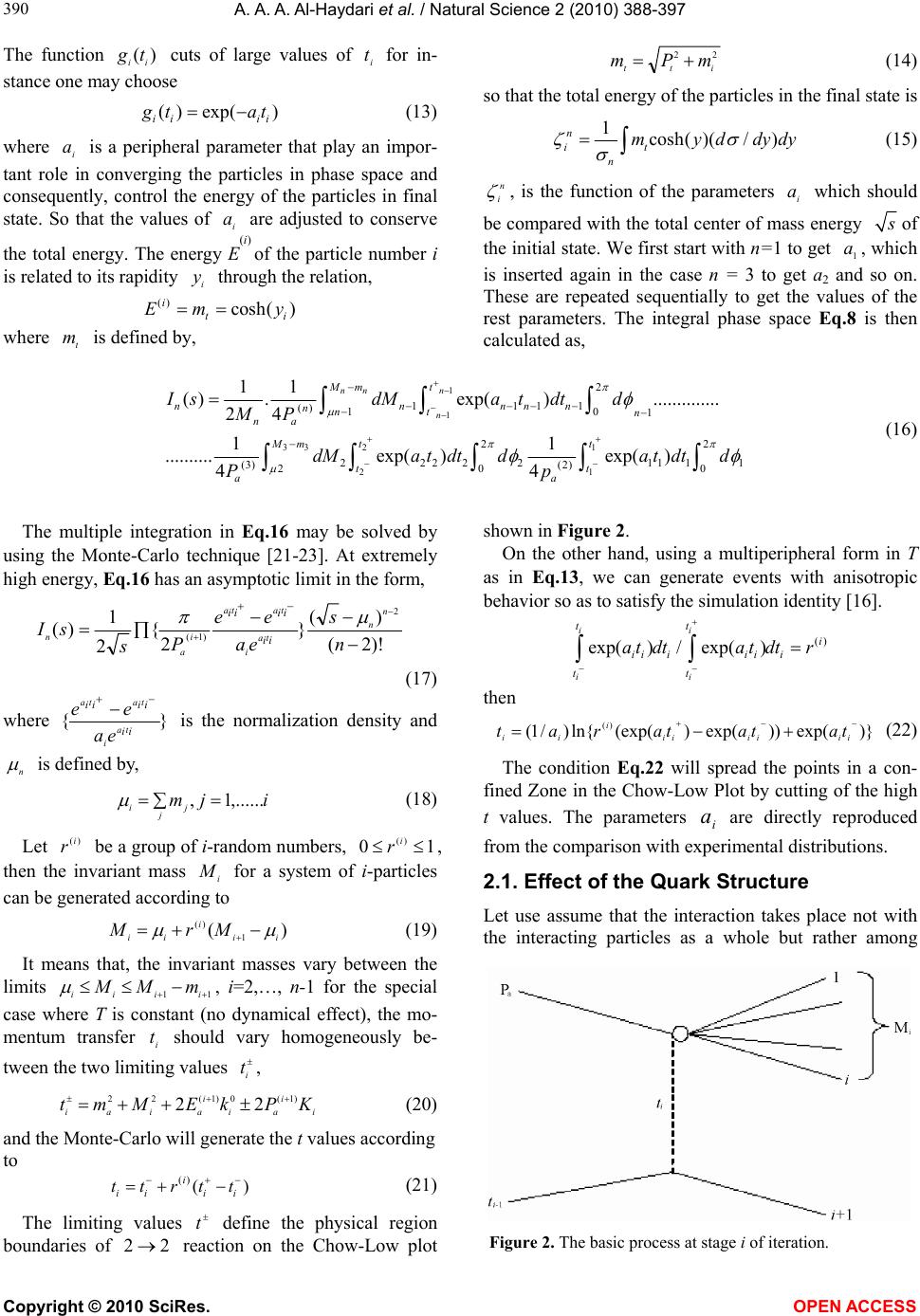 A. A. A. Al-Haydari et al. / Natural Science 2 (2010) 388-397 Copyright © 2010 SciRes. OPEN ACCESS 390 The function )( ii tg cuts of large values of i t for in- stance one may choose () exp() ii ii g tat (13) where i a is a peripheral parameter that play an impor- tant role in converging the particles in phase space and consequently, control the energy of the particles in final state. So that the values of i a are adjusted to conserve the total energy. The energy E (i) of the particle number i is related to its rapidity i y through the relation, () cosh( ) i ti Em y where t m is defined by, 22 itt mPm (14) so that the total energy of the particles in the final state is 1cosh( )(/) n it n myddydy (15) n i , is the function of the parameters i a which should be compared with the total center of mass energy s of the initial state. We first start with n=1 to get 1 a, which is inserted again in the case n = 3 to get a2 and so on. These are repeated sequentially to get the values of the rest parameters. The integral phase space Eq.8 is then calculated as, 1 1 33 21 21 2 1111 () 10 1 22 22222 1111 (3) (2) 20 0 11 ( ).exp().............. 24 11 ..........exp()exp( ) 44 nn n n Mm t nnnnn nnt n na Mm tt tt aa IsdMat dtd MP dMatdtda tdtd Pp (16) The multiple integration in Eq.16 may be solved by using the Monte-Carlo technique [21-23]. At extremely high energy, Eq.16 has an asymptotic limit in the form, )!2( )( } 2 { 2 1 )( 2 )1(n s ea ee P s sI n n ta i tata i a nii iiii (17) where }{ ii iiii ta i tata ea ee is the normalization density and n is defined by, ijm jji ,......1, (18) Let )(i r be a group of i-random numbers, 10 )( i r, then the invariant mass i M for a system of i-particles can be generated according to )(1 )( ii i ii MrM (19) It means that, the invariant masses vary between the limits 11 iiii mMM , i=2,…, n-1 for the special case where T is constant (no dynamical effect), the mo- mentum transfer i t should vary homogeneously be- tween the two limiting values i t, i i ai i aiai KPkEMmt )1(0)1(22 22 (20) and the Monte-Carlo will generate the t values according to () () i iii i tt rt t (21) The limiting values t define the physical region boundaries of 22 reaction on the Chow-Low plot shown in Figure 2. On the other hand, using a multiperipheral form in T as in Eq.13, we can generate events with anisotropic behavior so as to satisfy the simulation identity [16]. () exp( )/exp( ) ii ii tt i ii iii i tt at dtatdtr then )}exp())exp()(exp(ln{)/1( )( iiiiii i ii tatatarat (22) The condition Eq.22 will spread the points in a con- fined Zone in the Chow-Low Plot by cutting of the high t values. The parameters i a are directly reproduced from the comparison with experimental distributions. 2.1. Effect of the Quark Structure Let use assume that the interaction takes place not with the interacting particles as a whole but rather among Figure 2. The basic process at stage i of iteration.  A. A. A. Al-Haydari et al. / Natural Science 2 (2010) 388-397 Copyright © 2010 SciRes. OPEN ACCESS 391 their minute constituent quarks. Neglecting the spin ef- fect of the quark and considering, for example, πp, sys- tem as two bags containing, respectively, two and three quarks each of effective mass q m, we assume that the reaction goes through one of the following channels: 1) One of the projectile quarks interacts with one of the target quarks. We use the symbols () and () to describe the two states of the first channel. The number of possible permutation of these states is 3. 2) In the second channel, the two projectile quarks may interact with the three target quarks in a collective manner. This state is symbolized by () with only one possible permutations. The square of the cen- ter-of-mass energy of each state is calculated according to; qqaqqba eNNmmNNs 2)(222 (23) where a N and b N are the number of quarks partici- pating in the reaction from the target and projectile, re- spectively; q m is the effective quark mass and q e is the laboratory energy per quark. The multiplicity distri- bution )(nF of an n-particle system is calculated in terms of the distribution functions of the different states of the reaction. For our example case (π p-system), let us assume that )( 11 nf and )( 12 nf represent the phase space integrals of the state () and () for the first channel, so that the distribution of the first channel is obtained by a restricted superposition of the two functions; 11112 ()()[(()())(())] ij f nZnfifjnij (24) where the normalization factor, )(nZ is given by 1 () [(())] ij Znni j (25) The second channel has only one state () represented by a phase space integral )( 2nf , then the overall distribution function )( nF is 2211 )( fkfknF (26) where 1 k and 2 k are the number of possible permuta- tions in each channel. The distribution function for any other physical quantity x is simply given by 11 22 ()() () i H xk hxkhx (27) 2.1.1. Hadron-Nucleus Collision On extending the model to the hadron-nucleus or nu- cleus-nucleus collision, we follow the NN-base super position as expected from the features of the experimen- tal data. We should consider the possible interactions with the nucleons forming the target nucleus t A. The incident hadron makes successive collisions inside the target. The energy of the incident hadron (leading parti- cle) slows down after each collision, producing a num- ber of created hadrons each time which depends on the available energy. The phase space integral In NA in this case has the form; ()()(,) () tt AA NA nnvvti vi I sIsPvAnn (28) where ),( t AP is the probability that ν nucleons out of t A will interact with the leading particle and )( sIn is the phase space integral of NN collision that produces hadrons at energy s. The delta function in Eq.28 is to conserve the number of particles in the final state. All the nucleons are treated identically, and the NN X is the N-N phase shift function [20,24-26]. Then, according to the eikonal approximation, (,)( 1){1exp(2Re())} j l t ttNN j Al pl Ai Alj X j l (29) This approach was then worked out by putting the multi-dimension integration of Eq.16 and the generated kinematical variables into a Monte-Carlo program which was created by the author. This in turn is restored ν times, where ν is the number of collisions inside the tar- get nucleus that is generated by a Monte-Carlo Genera- tor according to the probability distribution Eq.29. In the first one, the incident hadron has its own incident energy and moves parallel to the collision axis (0)( 0 axisZ . The output of the program determines the number of created hadrons 1 n as well as the energy )( 01 EE and the direction 1 q of the leading particle. The leading particle leads the reaction in its second round with 1 E and 1 as input parameters and creates new number of 2 n and so on. The number j n is determined ac- cording to a multiplicity generator which depends on the square of the center of mass energy j s in the round number j: jNNjEmms 22 2 (30) 3. NUCLEUS-NUCLEUS COLLISIONS The extension of the multi peripheral model to the nu- cleus-nucleus case is more complicated. The number of available collisions is multi-folded due to the contribu- tion of the projectile nucleons. By analogy of the AN  A. A. A. Al-Haydari et al. / Natural Science 2 (2010) 388-397 Copyright © 2010 SciRes. OPEN ACCESS 392 collision, it is possible to define the phase space integral AA n I in A A collisions as, ,,, , ()()(,, ,) () ptt jk AAA NN nnjkAAptjk jk jk IsIsPjAkAn n (31) where )( , ,kjn sI kj is the phase space integral due to the knocked on nucleon number j from the projectile and that, number k from the target. The probability that the A A collision encounters events. So that, ),().,(),,,( ttpptpAA AvPAvPAkAjP (32) About 1000 events have been generated for each reac- tion by the Monte-Carlo according to the decay diagram of Figure 1. 4. THEORETICAL CALCULATION 4.1. The Multi-Peripheral Parameters i a with n Particle Final State The values of the multi-peripheral parameters i a play an important role in the calculation of the phase space integrals and the inclusive cross sections. The multi- peripheral parameters carry all the dynamical effects that control the geometrical and kinematical behavior of the reactions. The values of i a are considered as fitting parameters and are determined to conserve the total en- ergy in the center of mass of the reaction [17]. Taking all possible configurations (pairing) of quark combinations as described in Subsection 2.1. Referring to equations Eq.12 and Eq.13 we find that the parameter n a, plays the effective role in the dy- namic matrix element which controls the generation process of the events according to the assumed number of produced particles b n and the square of the available energy in the center of mass s. The parameter n a is just a fitting parameter in the simulation process. Its value is to conserve the energy in the generator G(n). Figure 3. The flow chart of the Monte Carlo code for p-p collisions. 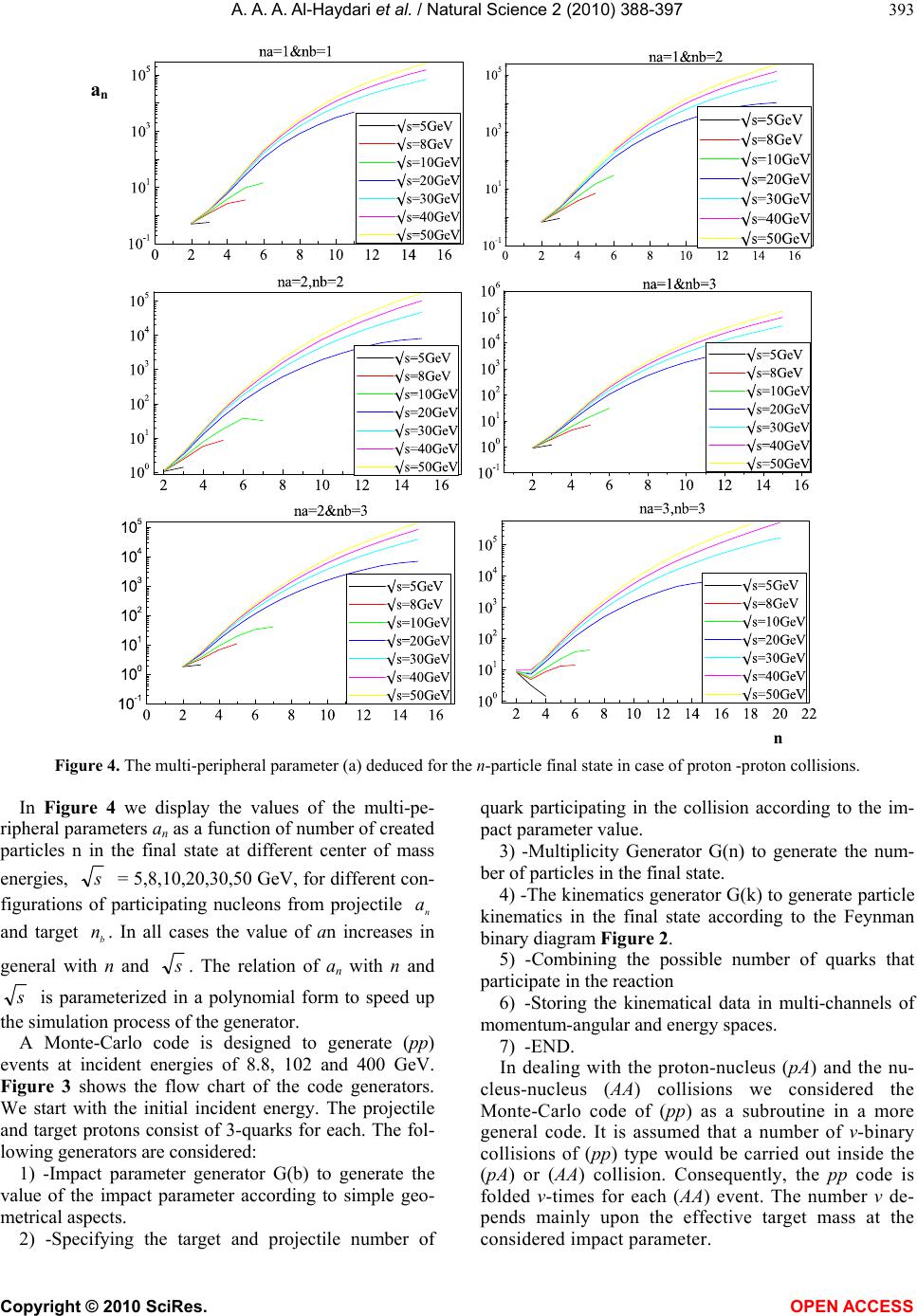 A. A. A. Al-Haydari et al. / Natural Science 2 (2010) 388-397 Copyright © 2010 SciRes. OPEN ACCESS 393 a n n Figure 4. The multi-peripheral parameter (a) deduced for the n-particle final state in case of proton -proton collisions. In Figure 4 we display the values of the multi-pe- ripheral parameters an as a function of number of created particles n in the final state at different center of mass energies, s = 5,8,10,20,30,50 GeV, for different con- figurations of participating nucleons from projectile n a and target b n. In all cases the value of an increases in general with n and s. The relation of an with n and s is parameterized in a polynomial form to speed up the simulation process of the generator. A Monte-Carlo code is designed to generate (pp) events at incident energies of 8.8, 102 and 400 GeV. Figure 3 shows the flow chart of the code generators. We start with the initial incident energy. The projectile and target protons consist of 3-quarks for each. The fol- lowing generators are considered: 1) -Impact parameter generator G(b) to generate the value of the impact parameter according to simple geo- metrical aspects. 2) -Specifying the target and projectile number of quark participating in the collision according to the im- pact parameter value. 3) -Multiplicity Generator G(n) to generate the num- ber of particles in the final state. 4) -The kinematics generator G(k) to generate particle kinematics in the final state according to the Feynman binary diagram Figure 2. 5) -Combining the possible number of quarks that participate in the reaction 6) -Storing the kinematical data in multi-channels of momentum-angular and energy spaces. 7) -END. In dealing with the proton-nucleus (pA) and the nu- cleus-nucleus (AA) collisions we considered the Monte-Carlo code of (pp) as a subroutine in a more general code. It is assumed that a number of ν-binary collisions of (pp) type would be carried out inside the (pA) or (AA) collision. Consequently, the pp code is folded ν-times for each (AA) event. The number ν de- pends mainly upon the effective target mass at the considered impact parameter. 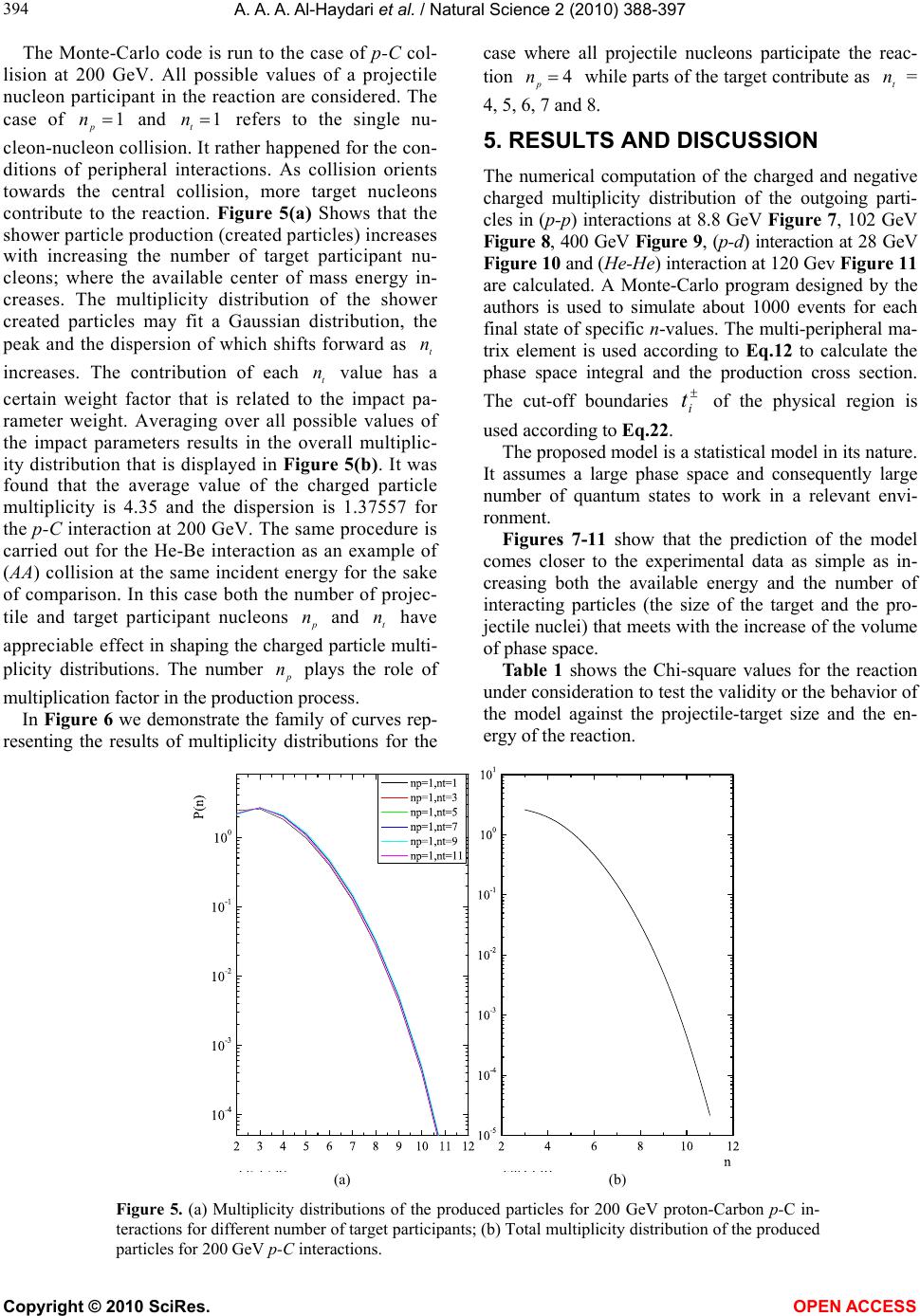 A. A. A. Al-Haydari et al. / Natural Science 2 (2010) 388-397 Copyright © 2010 SciRes. OPEN ACCESS 394 The Monte-Carlo code is run to the case of p-C col- lision at 200 GeV. All possible values of a projectile nucleon participant in the reaction are considered. The case of 1 p n and 1 t n refers to the single nu- cleon-nucleon collision. It rather happened for the con- ditions of peripheral interactions. As collision orients towards the central collision, more target nucleons contribute to the reaction. Figure 5(a) Shows that the shower particle production (created particles) increases with increasing the number of target participant nu- cleons; where the available center of mass energy in- creases. The multiplicity distribution of the shower created particles may fit a Gaussian distribution, the peak and the dispersion of which shifts forward as t n increases. The contribution of each t n value has a certain weight factor that is related to the impact pa- rameter weight. Averaging over all possible values of the impact parameters results in the overall multiplic- ity distribution that is displayed in Figure 5(b). It was found that the average value of the charged particle multiplicity is 4.35 and the dispersion is 1.37557 for the p-C interaction at 200 GeV. The same procedure is carried out for the He-Be interaction as an example of (AA) collision at the same incident energy for the sake of comparison. In this case both the number of projec- tile and target participant nucleons p n and t n have appreciable effect in shaping the charged particle multi- plicity distributions. The number p n plays the role of multiplication factor in the production process. In Figure 6 we demonstrate the family of curves rep- resenting the results of multiplicity distributions for the case where all projectile nucleons participate the reac- tion 4 p n while parts of the target contribute as t n = 4, 5, 6, 7 and 8. 5. RESULTS AND DISCUSSION The numerical computation of the charged and negative charged multiplicity distribution of the outgoing parti- cles in (p-p) interactions at 8.8 GeV Figure 7, 102 GeV Figure 8, 400 GeV Figure 9, (p-d) interaction at 28 GeV Figure 10 and (He-He) interaction at 120 Gev Figure 11 are calculated. A Monte-Carlo program designed by the authors is used to simulate about 1000 events for each final state of specific n-values. The multi-peripheral ma- trix element is used according to Eq.12 to calculate the phase space integral and the production cross section. The cut-off boundaries i t of the physical region is used according to Eq.22. The proposed model is a statistical model in its nature. It assumes a large phase space and consequently large number of quantum states to work in a relevant envi- ronment. Figures 7-11 show that the prediction of the model comes closer to the experimental data as simple as in- creasing both the available energy and the number of interacting particles (the size of the target and the pro- jectile nuclei) that meets with the increase of the volume of phase space. Table 1 shows the Chi-square values for the reaction under consideration to test the validity or the behavior of the model against the projectile-target size and the en- ergy of the reaction. (a) (b) Figure 5. (a) Multiplicity distributions of the produced particles for 200 GeV proton-Carbon p-C in- teractions for different number of target participants; (b) Total multiplicity distribution of the produced particles for 200 GeV p-C interactions. 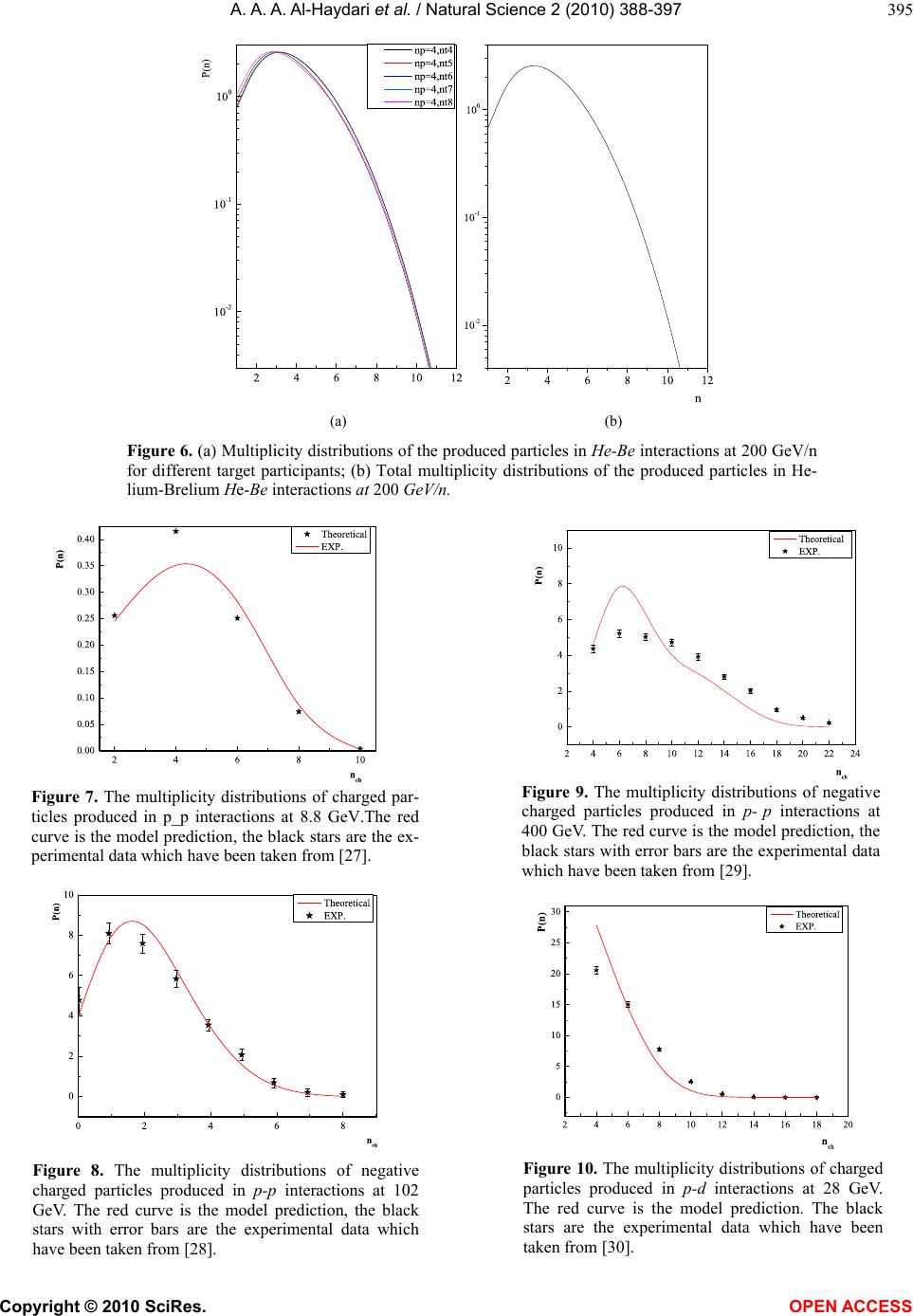 A. A. A. Al-Haydari et al. / Natural Science 2 (2010) 388-397 Copyright © 2010 SciRes. OPEN ACCESS 395 (a) (b) Figure 6. (a) Multiplicity distributions of the produced particles in He-Be interactions at 200 GeV/n for different target participants; (b) Total multiplicity distributions of the produced particles in He- lium-Brelium He-Be interactions at 200 GeV/n. Figure 7. The multiplicity distributions of charged par- ticles produced in p_p interactions at 8.8 GeV.The red curve is the model prediction, the black stars are the ex- perimental data which have been taken from [27]. Figure 8. The multiplicity distributions of negative charged particles produced in p-p interactions at 102 GeV. The red curve is the model prediction, the black stars with error bars are the experimental data which have been taken from [28]. Figure 9. The multiplicity distributions of negative charged particles produced in p- p interactions at 400 GeV. The red curve is the model prediction, the black stars with error bars are the experimental data which have been taken from [29]. Figure 10. The multiplicity distributions of charged particles produced in p-d interactions at 28 GeV. The red curve is the model prediction. The black stars are the experimental data which have been taken from [30].  A. A. A. Al-Haydari et al. / Natural Science 2 (2010) 388-397 Copyright © 2010 SciRes. OPEN ACCESS 396 Figure 11. The multiplicity distribution of the particles pro- duced in He-He interactions at 120 GeV. The red curve is the model prediction. The black stars are the experimental data which have been taken from [31]. Table 1. The Chi-square of the reactions. Reaction Energy Chi-Square p − p 8.8 GeV 0.005066 p − p 102 GeV 0.004561 p − p 400 GeV 0.822473 p − d 28 Gev 0.034502 He-He 120 GeV 0.000382 5. CONCLUSIONS The multi-peripheral model is extended to the nu- cleon-nucleus and the nucleus-nucleus interaction on the basis of nucleon-nucleon collisions, where the phase space integral of the nucleon-nucleon and nucleus-nu- cleus interaction is folded several times according to the number of encountered nucleons from the target. The number of created particles in each collision is summed over to get the production in the nucleon-nucleon case, where the conservation of number of particles in the final state is taken into consideration. The inclusive cross section is calculated and showed a fair agreement with experimental data. REFERENCES [1] Bjorken, J.D. (1983) Principles of opticsoo. Physical Review D, 27, 140. [2] Busza, W. and Goldhaber, A. (1984) Nuclear stopping power. Physics Letters B, 139(4), 235-238. [3] Barton, D.S., et al. (1983) Experimental-study of the A-dependence of inclusive hadron fragmentation. Physi- cal Review D, 27(11), 2580-2599. [4] Andersson, B., Gustafson, G. and Nilsson-Almqvist, B. (1987) A model for low-pT hadronic reactions with gen- eralizations to hadron-nucleus and nucleus-nucleus colli- sions. Nuclear Physics B, 281(1-2), 289-309. [5] Nilsson-Almqvist, B. and Stenlund, E. (1987) Interac- tions between hadrons and nuclei: The Lund Monte Carlo - FRITIOF version 1.6. Computer Physics Com- munications, 43(3), 387-397. [6] Sorge, H., Von Keitz, A., Mattiello, R., Stocker, H. and Greiner, W. (1990) Energy density, stopping and flow in 10-20 A GeV heavy ion collisions. Physics Letters B, 243, 7-12. [7] Mattiello, R., et al. (1991) Multistrangeness production in heavy ion collisions. Nuclear Physics B, 24(2), 221-233. [8] Wang, X.N. and Gyulassy, M. (1991) HIJING: A Monte Carlo model for multiple jet production in pp, pA, and AA collisions. Physical Review D, 44, 3501-3516. [9] Geiger, K. and Muller, B. (1992) Dynamics of parton cascades in highly relativistic nuclear collisions. Nuclear Physics A, 544(2), 467-470. [10] Geiger, K. (1992) Thermalization in ultrarelativistic nu- clear collisions I. Parton kinetics and quark-gluon plasma formation. Physical Review D, 46(11), 4965. [11] Geiger, K. (1993) Particle production in high energy nuclear collisions: Parton cascade—cluster hadronization model. Physical Review D, 47, 133. [12] Brenner, A.E., et al. (1982) Experimental study of sin- gle-particle inclusive hadron scattering and associated multiplicities. Physical Review D, 26, 1497-1553. [13] Amati, D., Stanghellini, A. and Fubini, S. (1962) Theory of high-energy scattering and multiple production. Nuovo Cimento, 26, 896-954. [14] Hassan, N.M. (2007), Charged particle multiplicity pro- duced in neutrino-nucleon interactions at high energies. Scientific Research and Essays, 2(6), 171-176. [15] Hussein, M.T., Hassan, N. M. and Rabea, A. (1994) ICTP, Trieste, internal report IC/93/111. Nuovo Cimento A, 107, 749. [16] Hussein, M.T. (1993) ICTP, Trieste, internal report IC/92/166. Nuovo Cimento A, 106, 481. [17] Byckling, E. and Kajantie, K. (1973) Particle kinematics. John Wiley and Sons, New York, 190. [18] Hussein, M.T., Hassan, N.M. and Rabea, A. (1994) Hadron fragmentation at high energies. Particle World, 4(1), 4. [19] Hussein, M.T., Hassan, N.M. and Allam, M.A. (1997) A Multi-cluster model in hadron nucleus interactions at high energies. Turkish Journal of Physics, 21, 241. [20] Hegab, M.K., Hussein, M.T. and Hassan, N.M. (1990) Nucleus-nucleus collisions at high energies. Zeitschrift für Physik A, 336, 345. [21] Hussein, M.T. (1996) Monte Carlo simulation for hadron fragmentation at high energies. Invited Talk, First Inter- national Conference on Basic Science and Advanced Technology, Assiut, 9-12 November 1996. [22] Hussein, M.T., Rabea, A., El-Naghy, A. and Hassan, N.M. (1995) A string model for hadron interactions at high en- ergies. Progress of Theoretical Physics Japan, 93(3), 585. [23] Hassan, N.M., El-Harby, N. and Hussein, M.T. (2000) A Monte Carlo generator for high energy nucleus-nucleus collision. Acta Physiologica Academiae Scientiarum Hun- garicae, 12, 33-46. [24] Meggiolaro, E. (1998) High-energy quark-quark scatter- ing and the eikonal approximation. Nuclear Physics B- Proceedings Supplements, 64, 191. [25] Pereira, F. and Ferreira, E. (1999) Eikonal profile func- 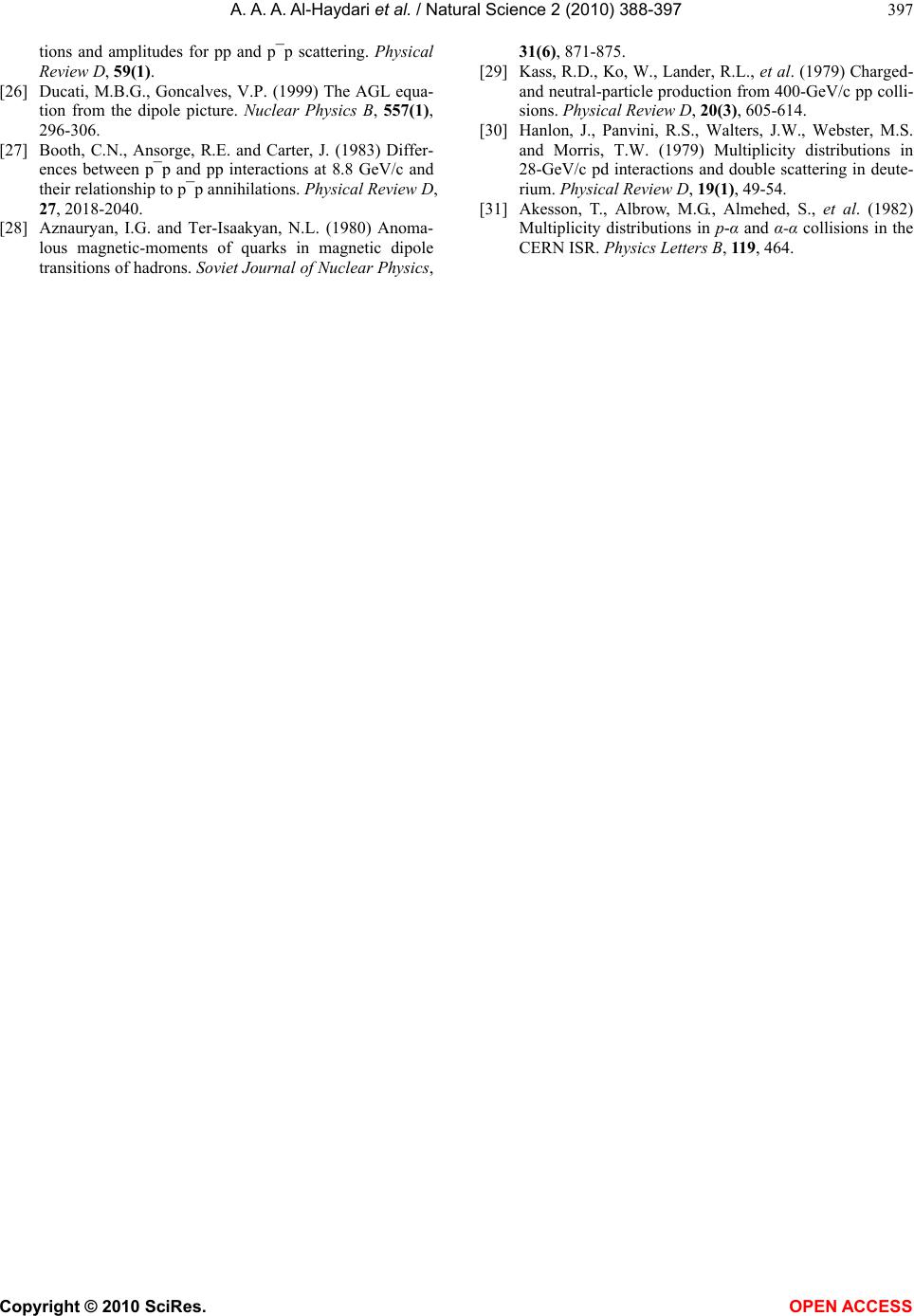 A. A. A. Al-Haydari et al. / Natural Science 2 (2010) 388-397 Copyright © 2010 SciRes. OPEN ACCESS 397 tions and amplitudes for pp and p¯p scattering. Physical Review D, 59(1). [26] Ducati, M.B.G., Goncalves, V.P. (1999) The AGL equa- tion from the dipole picture. Nuclear Physics B, 557(1), 296-306. [27] Booth, C.N., Ansorge, R.E. and Carter, J. (1983) Differ- ences between p¯p and pp interactions at 8.8 GeV/c and their relationship to p¯p annihilations. Physical Review D, 27, 2018-2040. [28] Aznauryan, I.G. and Ter-Isaakyan, N.L. (1980) Anoma- lous magnetic-moments of quarks in magnetic dipole transitions of hadrons. Soviet Journal of Nuclear Physics, 31(6), 871-875. [29] Kass, R.D., Ko, W., Lander, R.L., et al. (1979) Charged- and neutral-particle production from 400-GeV/c pp colli- sions. Physical Review D, 20(3), 605-614. [30] Hanlon, J., Panvini, R.S., Walters, J.W., Webster, M.S. and Morris, T.W. (1979) Multiplicity distributions in 28-GeV/c pd interactions and double scattering in deute- rium. Physical Review D, 19(1), 49-54. [31] Akesson, T., Albrow, M.G., Almehed, S., et al. (1982) Multiplicity distributions in p-α and α-α collisions in the CERN ISR. Physics Letters B, 119, 464. |

